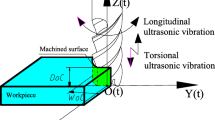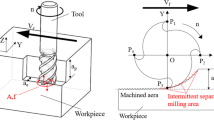Abstract
As a new method developed for machining difficult-to-cut materials, ultrasonic vibration–assisted machining technology not only could be effective in reducing cutting force and temperature but also could be significant in obtaining residual compressive stress. Especially, residual compressive stress is essential to realize anti-fatigue manufacturing for components. However, in recent years, research on residual stresses of ultrasonic vibration–assisted machining mainly focuses on experimental and finite element analysis methods. In this paper, an analytical model was established by considering the effect of ultrasonic vibration to predict residual stresses and reveal the mechanism for UVM of in situ TiB2/Al-MMCs. And a series of experiments were conducted to verify the residual stress model proposed and analyze the effect of ultrasonic vibration and cutting parameters on the surface residual stress. The results show that the predicted residual stresses are in good agreement with measured residual stress. Cutting parameters have a significant effect on the surface residual stress by influencing cutting force and cutting temperature. Residual compressive stresses could be achieved in both UVM and conventional milling, and residual compressive stresses in the former are larger than that in the latter. With cutting speed and cutting depth increasing, the relative increase ratio between UVM, and CM decreased gradually, while with feed rate increasing, it increased first and then decreased slightly.

















Similar content being viewed by others
Data availability
All authors confirm that the data supporting the findings of this study are available within the article.
Code availability
Not applicable.
Change history
07 August 2022
Springer Nature’s version of this paper was updated to remove the e-mail address of the co-author in the paper.
References
Huang XD, Zhang XM, Ding H (2016) A novel relaxation-free analytical method for prediction of residual stress induced by mechanical load during orthogonal machining. Int J Mech Sci 115–116:299–309
Xiong YF, Wang WH, Shi YY, Jiang RS, Shan CW, Liu XF, Lin KY (2021) Investigation on surface roughness, residual stress and fatigue property of milling in-situ TiB2/7050Al metal matrix composites. Chin J Aeronaut 34(4):451–464
Wan M, Ye XY, Yang Y, Zhang WH (2017) Theoretical prediction of machining-induced residual stresses in three-dimensional oblique milling processes. Int J Mech Sci 133:426–437
Sharma V, Pandey PM (2016) Optimization of machining and vibration parameters for residual stresses minimization in ultrasonic assisted turning of 4340 hardened steel. Ultrasonics 70:172–182
Sharma V, Pandey PM (2016) Recent advances in ultrasonic: assisted turning: a step towards sustainability. Cogent Engineering 3(1):1–20
Nestler A, Schubert A (2014) Surface properties in ultrasonic vibration: assisted turning of particle reinforced aluminium matrix composites. Procedia CIRP 13:125–130
Zhang XY, Lu ZH, Sui H, Zhang DY (2018) Surface quality and residual stress study of high-speed ultrasonic vibration turning Ti-6Al-4Valloys. Procedia CIRP 71:79–82
Iwabe H, Hiwatashi M, Jin M, Kanai H (2019) Side milling of helical end mill oscillated in axial direction with ultrasonic vibration. International Journal of Automation Technology 13(1):22–31
Chen G, Ren CZ, Zou YH, Qin XD, Liu LP, Li SP (2019) Mechanism for material removal in ultrasonic vibration helical milling ofTi-6Al-4V alloy. Int J Mach Tools Manuf 138:1–13
Zhang ML, Zhang DY, Geng DX, Shao ZY, Liu YH, Jiang XG (2020) Effects of tool vibration on surface integrity in rotary ultrasonic elliptical end milling of Ti-6Al-4V. J Alloy Compd 821:153266
Varun S, Pandey PM (2016) Optimization of machining and vibration parameters for residual stresses minimization in ultrasonic assisted turning of 4340 hardened steel. Ultrasonics 70:172–182
Hu HJ, Sun YZ, Lu ZS (2011) Simulation of residual stress in ultrasonic vibration assisted micro-milling. Advanced Materials Research 188:381–384
Maroju NK, Pasam VK (2019) FE modeling and experimental analysis of residual stresses in vibration assisted turning of Ti6Al4V. Int J Precis Eng Manuf 20(3):417–425
Feng YX, Hsu FC, Lu YT, Lin YF, Lin CT, Lin CF, Lu YC, Liang SY (2019) Residual stress prediction in ultrasonic vibration-assisted milling. The International Journal of Advanced Manufacturing Technology 104(5–8):2579–2592
Niu Y, Jiao F, Zhao B, Gao GF, Niu JJ (2020) Theoretical investigation of machining-induced residual stresses in longitudinal torsional ultrasonic-assisted milling. The International Journal of Advanced Manufacturing Technology 108:3689–3705
Liu XF, Wang WH, Jiang RS, Xiong YF, Lin KY (2020) Tool wear mechanisms in axial ultrasonic vibration assisted milling in-situ TiB2/7050Al metal matrix composites. Advances in Manufacturing 8(2):252–264
Xiong YF, Wang WH, Jiang RS, Lin KY, Song GD (2016) Surface integrity of milling in-situ TiB2 particle reinforced Al matrix composites. Int J Refract Metal Hard Mater 54:407–416
Liu XF, Wang WH, Jiang RS, Xiong YF, Lin KY, Li JC, Shan CW (2020) Analytical model of cutting force in axial ultrasonic vibration-assisted milling in-situ TiB2/7050Al PRMMCs. Chin J Aeronaut 34(4):160–173
Komanduri R, Hou ZB (2000) Thermal modeling of the metal cutting process: part I—temperature rise distribution due to shear plane heat source. Int J Mech Sci 42(9):1715–1752
Venuvinod PK, Lau WS (1986) Estimation of rake temperature in free oblique cutting. International journal of machine tool design and research 26(1):1–14
Lin KY, Wang WH, Jiang RS, Xiong YF, Shan CW (2019) Thermo-mechanical behavior and constitutive modeling of in situ TiB2/7050 Al metal matrix composites over wide temperature and strain rate ranges. Materials 12:1–15
Teimouri R, Amini S, Guagliano M (2019) Analytical modeling of ultrasonic surface burnishing process: evaluation of residual stress field distribution and strip deflection. Mater Sci Eng, A 747:208–224
McDowell DL (1997) An approximate algorithm for elastic-plastic two-dimensional rolling/sliding contact. Wear 211(2):237–246
Wan M, Ye XY, Yang Y, Zhang WH (2017) Theoretical prediction of machining-induced residual stress in three-dimensional oblique milling processes. Int J Mech Sci 133:426–437
Liu XF, Wang WH, Jiang RS, Xiong YF, Lin KY, Li JC, Shan CW (2021) Analytical model of workpiece temperature in axial ultrasonic vibration-assisted milling in situ TiB2/7050Al PRMMCs. The International Journal of Advanced Manufacturing Technology 119(3):1659–1672
Sonia P, Jain JK, Saxena KK (2021) Influence of ultrasonic vibration assistance in manufacturing processes: a review. Mater Manuf Processes 36(13):1451–1475
Chen G, Ren CZ, Zou YH, Qin XD, Liu LP, Li SP (2019) Mechanism for material removal in ultrasonic vibration helical milling of Ti-6Al-4V alloy. Int J Mach Tools Manuf 138:1–13
Acknowledgements
Many thanks to the ultrasonic vibration equipment support from Xi’an Chao Ke Neng Ultrasonic Technology Research Institute Co., Ltd.
Funding
This work is sponsored by National Science and Technology Major Project (Grant No. 2017-VII-0015–0111).
Author information
Authors and Affiliations
Contributions
Xiaofen Liu: the guidance and planning of the overall thinking, optimized and guided the experimental process, performed data measurement and analysis, wrote the first draft, and revised the contents of the first draft. Wenhu Wang: provided financial support for materials and equipment, supervision, and reviewing the first draft. Ruisong Jiang: checking and reviewing the first draft. Yifeng Xiong: responsible for the planning of the overall thinking, experimental process, and data analysis, and revised and reviewed the first draft. Chenwei Shan: funding acquisition and financial support. All the authors read and approved the final manuscript.
Corresponding author
Ethics declarations
Ethics approval
The manuscript has not been submitted to any other journal for simultaneous consideration. The submitted work is original and has not been published elsewhere in any form or language.
Consent to participate
All authors voluntarily agree to participate in this research study.
Consent for publication
All authors voluntarily agree to publish in this research study.
Conflict of interest
The authors declare no competing interests.
Additional information
Publisher's Note
Springer Nature remains neutral with regard to jurisdictional claims in published maps and institutional affiliations.
Rights and permissions
Springer Nature or its licensor holds exclusive rights to this article under a publishing agreement with the author(s) or other rightsholder(s); author self-archiving of the accepted manuscript version of this article is solely governed by the terms of such publishing agreement and applicable law.
About this article
Cite this article
Liu, X., Wang, W., Jiang, R. et al. Residual stress prediction in axial ultrasonic vibration–assisted milling in situ TiB2/7050Al MMCs. Int J Adv Manuf Technol 121, 7591–7606 (2022). https://doi.org/10.1007/s00170-022-09845-2
Received:
Accepted:
Published:
Issue Date:
DOI: https://doi.org/10.1007/s00170-022-09845-2




